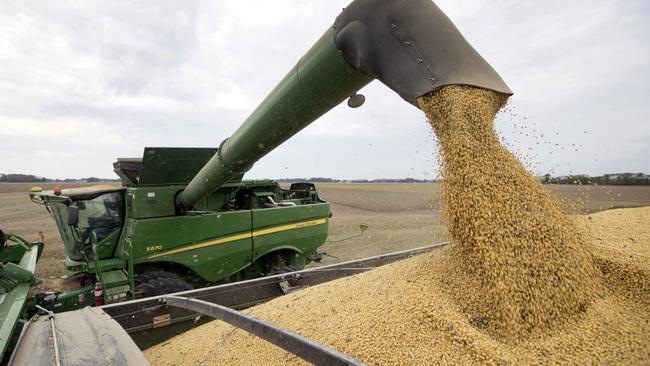US, Chinese trade negotiators plan for delay to new tariffs
US and Chinese trade negotiators are laying the groundwork for a delay of a fresh round of tariffs set to kick in on Sunday.

US and Chinese trade negotiators are laying the groundwork for a delay of a fresh round of tariffs set to kick in on Sunday, as they haggle over how to get Beijing to commit to massive purchases of US farm products on which President Donald Trump is insisting for a near-term deal.
In recent days, officials in Beijing and Washington have signalled that Sunday isn’t the final date for reaching a so-called phase-one deal — even though that is the date Mr Trump has set for tariffs to increase on $US165bn ($240bn) of Chinese goods.
That date could be extended, as has happened several times when the two sides thought they were on the verge of a deal. Those prior deals, though, never held and tariffs continued to mount.
Chinese and US officials involved in the talks said they didn’t have a hard deadline. On Friday, White House economics adviser Larry Kudlow said there were “no arbitrary deadlines”. Such remarks from Mr Kudlow have in the past reflected the President’s views and have been echoed privately by other US officials.
At The Wall Street Journal’s CEO Council meeting on Tuesday, Mr Kudlow said the December 15 tariffs were “still on the table” if Mr Trump wasn’t happy with the outcome of talks.
“If it’s not the kind of deal he wants, then the December 15 scheduled tariffs will go back into place,” Mr Kudlow said.
He said removal of some existing tariffs was part of the discussion with Chinese officials over a phase-one deal.
Commerce Secretary Wilbur Ross, when asked if the December 15 tariffs would take effect, said it was “more important to get a good deal for the US”. A week ago, Mr Ross said the tariffs would go up if both sides did not have a deal by the date.
With both sides hinting that negotiations could be extended, Mr Trump has gone back and forth in his public remarks between threatening a prolonged trade battle and trying to calm investors. Mr Trump hasn’t made his decision, and he has overridden his trade advisers several times to add tariffs.
The talks are dragging on. Working-level negotiators talk on most days, but as of Friday lead negotiators on both sides hadn’t spoken for 10 days. US Trade Representative Robert Lighthizer has been tied up working on the US-Mexico-Canada Agreement.
The biggest holdup in the trade negotiations is Washington’s demand that China guarantee its pledge to buy more US soybeans, poultry and other agriculture products.
For the Americans, purchases are the centrepiece of the limited deal. Mr Trump has made clear that more farm buys from China are the top priority for a near-term deal. US farmers who would benefit are Mr Trump’s key supporters in his re-election bid next year.
Other issues at the heart of the trade war include Chinese subsidies to domestic companies and pressure on US firms to hand over technology. They are largely being pushed back for future negotiation.
Specifically, US negotiators, led by Mr Lighthizer, have asked their Chinese counterparts to commit to some agriculture purchases up front. The Chinese side wants to tie the size of the commitment to how much tariff relief the US would be willing to extend immediately. It is unclear how much the US is pressing for, though Treasury Secretary Steven Mnuchin has said China had committed to annual purchases of $US40bn-$US50bn a year within the second year of a deal.
In addition, the US side is pressing China to specify in the text of the deal that there would be a quarterly review of promised purchases and that the purchase amount wouldn’t drop by 10 per cent in any quarter.
Chinese negotiators, led by Vice Premier Liu He, have pushed back against the demand while arguing that any guaranteed purchases would violate the rules of the World Trade Organisation and cause friction between China and its other trading partners.
Mr Liu’s team has also been trying hard to get the US not just to eliminate the December levies but also to relax portions of the existing tariffs on the $US360bn of Chinese imports. But Mr Lighthizer has so far held firm on not rolling back tariffs — a point of leverage seen as key to keeping the Chinese side engaged in negotiations over knottier issues such as subsidies and forced technology transfers. Other senior officials have indicated they are willing to eliminate the last round of tariffs, on $US110bn of Chinese goods.
“Neither side wants to blink first,” said Myron Brilliant, the US Chamber of Commerce’s executive vice-president. “But both governments realise they need to bank the progress being made and finalise a deal before tensions rise further.”
The US is scheduled to add 15 per cent tariffs on roughly $US165bn of Chinese products on Sunday, unless the two sides cut a deal, or Mr Trump decides to suspend the tariffs to allow negotiations to continue. Neither the Chinese nor many on the American side want those tariffs to go into effect. They would hit mobile phones, laptops, toys and clothing.
For the Chinese, fresh tariffs would deepen the country’s economic problems. The latest official data show China’s exports to the US plunged 23 per cent in November from a year earlier, continuing a trend of double-digit percentage declines that is exacerbating a slowdown in the Chinese economy. For the Americans, the tariffs could prompt a consumer reaction in the US., undermining political support for the trade battle.



To join the conversation, please log in. Don't have an account? Register
Join the conversation, you are commenting as Logout